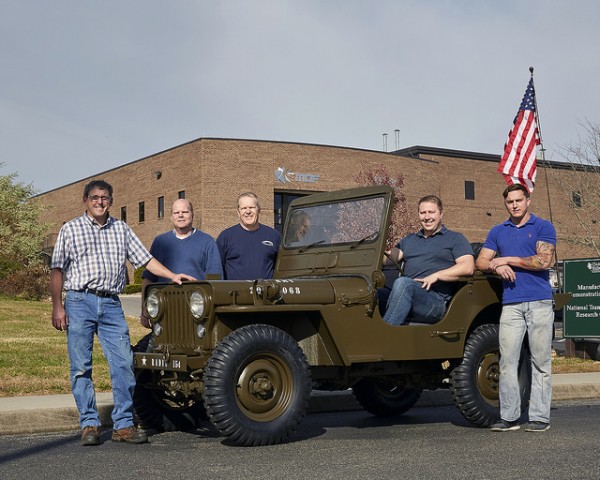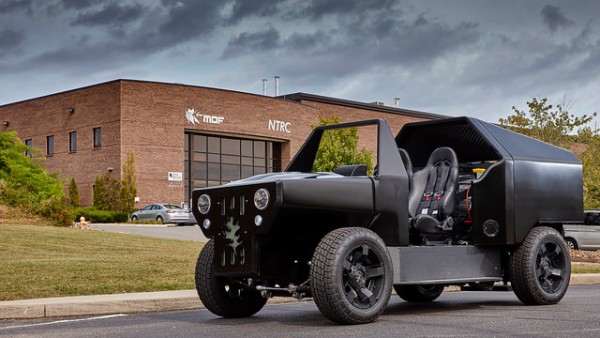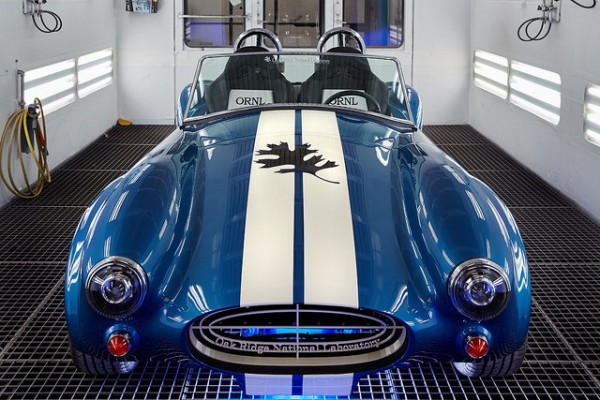
Oak Ridge National Laboratory has helped produce the first fully functional excavator that uses parts made through additive manufacturing, or 3D printing. The excavator is pictured above on Feb. 27, 2017. (Photo courtesy of Oak Ridge National Laboratory, U.S. Dept. of Energy)
Oak Ridge National Laboratory has helped produce the first fully functional excavator that uses parts made through additive manufacturing, or 3D printing.
The excavator, part of a working demonstration known as Project AME, was made in collaboration with ORNL partners in industry, government, and academia. The project helps showcase a range of industrial applications for 3D printing, ORNL said.
Additive manufacturing is the process used to build something one layer at a time. Rather than ink, 3D printers use polymers.
One of the most well-known examples is the Shelby Cobra car 3-D printed on a large-scale polymer printer at ORNL’s Manufacturing Demonstration Facility in Hardin Valley. President Barack Obama and Vice President Joe Biden admired that vehicle—and joked about taking it for a spin—during a trip to East Tennessee in January 2015.
ORNL has been involved in other projects using 3D printing that have attracted attention, and the lab has posted photos of its 3D printed vehicles. You can see them here.
In August 2016, a tool printed by ORNL set a Guiness World Record for largest solid item manufactured on a 3D printer. It was a trim-and-drill tool that will be used to help make a wing part on the Boeing 777X airplane, a passenger jet, and it was printed on a 3D printer at the Manufacturing Demonstration Facility. It used mostly ABS (acrylonitrile butadiene styrene) mixed with about 20 percent carbon fiber. ABS is the same material used to produce Legos, and it’s a tough, strong polymer.
In September 2015, ORNL announced that a car and house built with 3D printers at the Manufacturing Demonstration Facility could provide power to each other. The building and the printed utility vehicle—or PUV—were part of a project called the Additive Manufacturing Integrated Energy, or AMIE, demonstration. The project was designed to answer “what if” questions that could lead to innovations in building and car construction and energy use, storage, and consumption.
In January 2015, the Shelby Cobra 3D printed at the Manufacturing Demonstration Facility was on stage during the visit by Obama and Biden to Techmer PM in Clinton. Obama said during that visit that the University of Tennessee in Knoxville would head a $259 million advanced manufacturing project and that Oak Ridge National Laboratory would play a key role. The Shelby Cobra was described as a shiny example of innovation, research, and collaboration between ORNL and UT, and the car was highlighted as an example of the changing world of manufacturing.
See ORNL’s photo album of 3D-printed vehicles on flickr here.

A Jeep 3D printed at Oak Ridge National Laboratory’s Manufacturing Demonstration Facility in Hardin Valley. Pictured above on Nov. 25, 2015, are, from left, Steve Whitted, Lonnie Love, Craig Blue, Brian Post, and Matt Sallas. (Photo courtesy of Oak Ridge National Laboratory, U.S. Dept. of Energy)

A Printed Utility Vehicle that used 3D printing as part of a project called the Additive Manufacturing Integrated Energy, or AMIE, demonstration, at Oak Ridge National Laboratory is pictured above on Sept. 22, 2015. (Carlos Jones photo courtesy of Oak Ridge National Laboratory, U.S. Dept. of Energy)

A Shelby Cobra 3D printed at Oak Ridge National Laboratory is pictured above on Jan. 7, 2015. (Photo courtesy of Oak Ridge National Laboratory, U.S. Dept. of Energy)

The Cincinnati Machine (a 3D printer) at work in Oak Ridge National Laboratory’s Manufacturing Demonstration Facility in Hardin Valley on Dec. 29, 2014. (Photo courtesy of Oak Ridge National Laboratory, U.S. Dept. of Energy)
More information will be added as it becomes available.
Do you appreciate this story or our work in general? If so, please consider a monthly subscription to Oak Ridge Today. See our Subscribe page here. Thank you for reading Oak Ridge Today.
Copyright 2016 Oak Ridge Today. All rights reserved. This material may not be published, broadcast, rewritten, or redistributed.
Dave Smith says
According an article published on the KNS website, the parts manufactured using 3D printing were the cab, the heat exchanger, and the lower section of the bucket arm. The article doesn’t discuss what might be the advantage of printing these parts instead of manufacturing them using conventional forging and metal forming processes.
johnhuotari says
I can’t say for sure in the case of the excavator, but I asked in August regarding the wing trim-and-drill tool that was made for Boeing and that was also 3D printed.
Officials and executives said then that the 30 hours needed to manufacture the wing trim tool at the Manufacturing Demonstration Facility saved significant time, compared to conventional processes.
From the article:
“It would normally take three months to make the trim-and-drill tool from a heavy, metal block, said Leo Christodoulou, chief engineer for materials and manufacturing technology in Boeing Research and Technology. Also, the metal tool would not be easily modified.
The 3D printed tool is thick. That’s to give it stiffness and rigidity, Christodoulou said.
…
ORNL Director Thom Mason said the 3D printed tool will save time, money, and energy. Christodoulou said it saved about 90 percent of the original cost and will allow for a perfect trim.
“This tool—it’s truly a breakthrough,” Christodoulou said.
He said Boeing has been using 3D printed items since as early as 2003 and now has about 50,000 non-structural 3D printed parts, such as those made of nylon. The record-setting tool printed by ORNL is the largest and most complex for Boeing, Christodoulou said.
“Additively manufactured tools, such as the 777X wing trim tool, will save energy, time, labor, and production costs and are part of our overall strategy to apply 3D printing technology in key production areas,” Christodoulou said.”
So, two apparent advantages, based on what we’ve previously reported, appear to be that a part can be made quicker and more easily modified. Plus there is an apparent cost savings.
Here’s the earlier story: http://bjq.6af.mytemp.website/2016/08/30/ornl-boeing-set-guinness-world-record-with-3d-printed-tool-for-boeing-777x-wing-part/